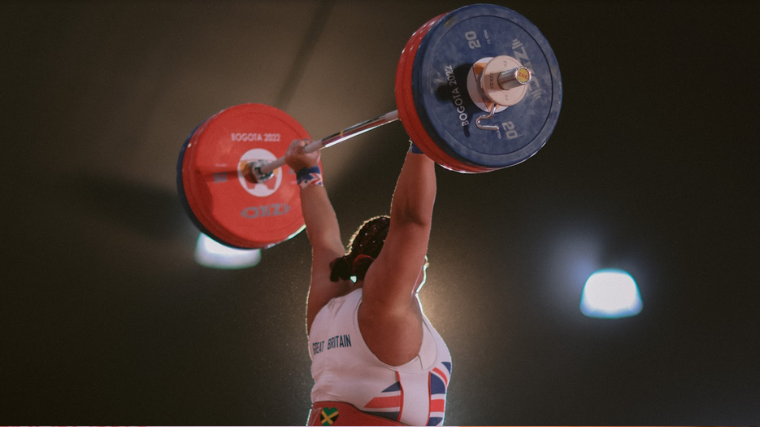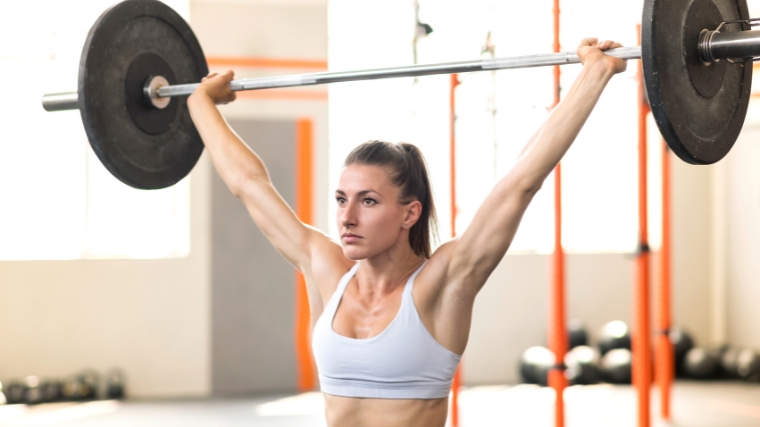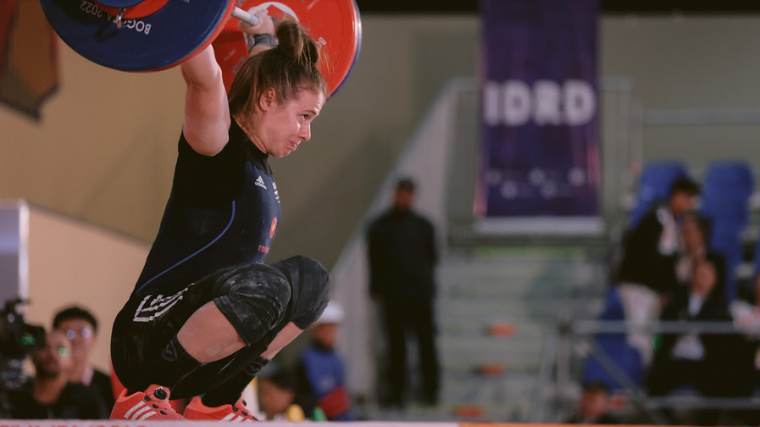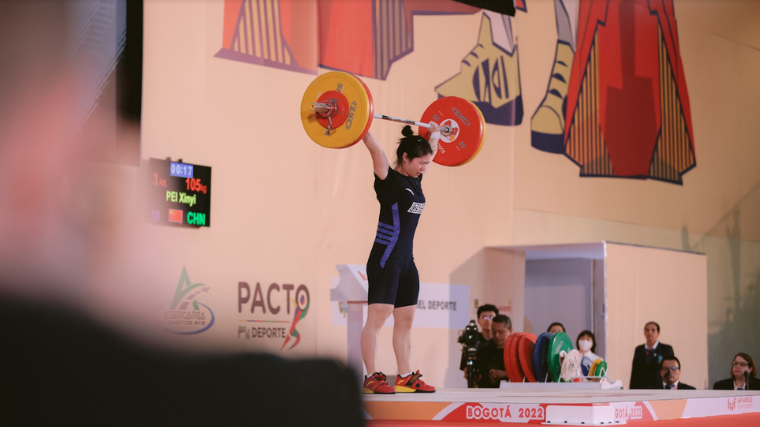For weightlifters, they’re inseparable. Pitting the snatch and clean & jerk — the two competitive movements in the sport of Olympic lifting — against one another is, in many ways, an exercise in futility. After all, you wouldn’t strictly compare a knife against a fork; in many cases, they work better as a pair.
That isn’t to say that the two movements are identical or interchangeable in all cases. Far from it, actually. If you’re an aspiring (or competitive) weightlifter, you have to get comfortable with them both, but not everyone dreams of lacing up their lifting shoes and stepping out onto the platform.

You can utilize the Olympic lifts for a wide variety of different athletic purposes. Whether you want to mix up your workout routine, improve your cardiovascular conditioning, or develop robust muscular strength, you need to know the strengths and weaknesses of the snatch and clean & jerk.
Differences Between the Snatch and Clean & Jerk
Insofar as differences go between the two, the snatch and clean & jerk are mostly separated by technique-based distinctions in pursuit of the main goal. When you perform either movement, your goal is to get a loaded barbell to arm’s length overhead as fast as possible. The two lifts are separated by how they help you go about completing that task.
Technical Complexity
Make no mistake, both the snatch and clean & jerk are far more intricate than your run-of-the-mill weight room workout. Launching a heavy barbell overhead and catching it takes skill, precision, and plenty of practice.
However, the clean & jerk has a more involved sequence of steps than the snatch. When you snatch, the barbell must remain in motion from the moment it leaves the floor until you receive it in an overhead squat.

On the other hand, the clean & jerk has two distinct phases. Getting the barbell from the floor to your shoulders (held in the front rack position) is one thing. You then have to vault it over your head. This doesn’t necessarily mean the clean & jerk is strictly harder than the snatch, but there are more moving parts.
Loading Potential
Both the snatch and the clean & jerk are two very viable ways of getting a barbell over your head. While the snatch is forceful and abrupt (the lift often begins and ends in only a few seconds) the clean & jerk is more of an expression of brute strength, comparatively.
Barring some severe technical deficiencies, you should be able to lift significantly more weight in the clean & jerk than the snatch. This is largely due to the differences in how you pull the bar off the floor — you simply don’t need to elevate the bar quite as high in the clean as you do when you snatch.
This enables you to work with heavier weights, which you then propel overhead from a standing position.
Flexibility Demands
Weightlifters, particularly career lifters who compete as far as the Olympic Games, are among the most flexible athletes on the planet. The sport demands extreme levels of mobility, particularly in the hips and shoulders.
Generally speaking, the snatch requires a greater level of flexibility than the clean & jerk. Not only do you need to sink into a very low, and often wide, squat position — you also have to have comprehensive range of motion access at the shoulder to suspend the barbell over your head at the same time.
Plenty of gymgoers can squat low or press a bar over their heads, but utilizing both joints at once, under load, is what makes the snatch so difficult.
Time Under Tension
Both the snatch and clean & jerk take only a few moments to complete. Some weightlifters can snatch maximal-effort weights in the literal blink of an eye, a far cry from the potentially-grindy 1-rep-maxes sometimes seen in powerlifting.

The clean & jerk is fast as well, though not to the same extent. Weightlifters often have to grind a heavy front squat out after they clean the barbell, take a few breaths to compose themselves, jerk the weight overhead, and then regain their footing. This amounts to more time under tension during the clean & jerk overall.
“No Lift” Rules
The snatch and clean & jerk share a partial rule set in weightlifting competitions, but there are a handful of lift-specific technical errors for each as well. For example, a snatch attempt is considered invalid if the barbell touches your head in the overhead squat.
During the clean & jerk, if your elbows make contact with any part of your body at any time, you forfeit the lift. You’re also forbidden from deliberately oscillating the barbell after standing up from the clean — doing so would give the bar extra momentum in the jerk phase.
Similarities Between the Snatch and Clean & Jerk
They may not be strictly interchangeable, but the snatch and clean & jerk bear more than a handful of similarities. Understanding how the two movements align can help you better decide which one is right for you, or how to program them both in tandem.
Prime Movers
Despite how each lift appears visually, athletes who perform the snatch and clean & jerk both rely almost entirely on their leg strength. In both movements, force generated from rapidly extending the knees and hips elevates the barbell in space.
Conversely, your upper body really only has to contract isometrically to hold the bar over your head (no easy feat to be sure). High-level weightlifters will use their arms to pull themselves underneath an already-moving barbell, but neither lift is considered an arm exercise whatsoever.
Intent
Cuing and mental intent are huge aspects of Olympic weightlifting for both the snatch and clean & jerk. The two lifts certainly have their own elements, but your intent when performing either of them is, broadly, the same.

In both lifts, the conceptual goal is to use your legs to pull the bar off the floor and adjust your body such that you’re in an advantageous position to impart vertical force. For the snatch, this will occur when the bar is in the crease of the hips; during the clean, it’s when the bar reaches your upper thigh. Regardless, the overarching movement goal is the same.
Objective
Both exercises share the same success criteria, at least in the context of a weightlifting meet. Whether you’re snatching or clean & jerking, the lift is not considered valid and complete until you stand fully upright, knees and elbows locked, feet in alignment, and have displayed control over the weight itself.
Snatch vs. Clean & Jerk Technique
If you want to learn to do the clean & jerk or the snatch, your best bet is to seek out the guidance of a qualified coach. Beyond that, breaking each lift down into its component parts can help you visualize and understand where they part ways in terms of technical execution.
How to Do the Snatch
To perform the snatch, you really only need a barbell and some bumper plates. You can also practice with something even lighter than the empty bar; a long dowel, some PVC piping, or even a broomstick all work fine.
- Stand upright with an empty barbell in your hands. Grab it wide enough that, with your arms relaxed, the bar gently touches the crease of your hips.
- Bend your knees and tip over at the waist so the barbell glides down your thighs towards the floor. As it passes your knees, sink down and allow your knees to drift in front of the bar. Your back should be flat, and your shoulders should be directly on top of the bar if viewed from the side. The bar should gently touch your shins.
- From here, take a small breath and reverse the motion. Push into the floor with your legs only, keeping your torso angle the same.
- As you push yourself back up toward a standing position, guide the bar into your hips and accelerate your speed. When the barbell touches your hip, extend your lower body forcefully.
- Allow the bar to travel upward as you yourself drop down into an overhead squat. Straighten your arms over your head to receive the barbell and then sink into as low of a squat as you are able.
If you’re lifting with bumper plates on your barbell, you can safely drop the bar in front of you once you stand up from the squat.
How to Do the Clean & Jerk
You’ll need a bar and some bumper plates to perform the clean & jerk as well. Practicing with a lighter implement is helpful, but many learners find that a little bit of weight in their hands helps the clean feel more intuitive.
- Set up for the clean the same way you would for the snatch. However, grip the bar as you would for a deadlift or row, with your hands just outside your thighs.
- From a standing position, sink down and tip over until the barbell is just under your knees. Check your posture to ensure your shoulders cover the bar and your back is flat.
- Reverse the motion, pushing hard into the floor with your legs.
- As the barbell comes up your thigh, rapidly accelerate and drive into the ground. Allow the bar to fly upward.
- Catch the bar in the front rack position by flipping your elbows up. Once you’ve secured it, sink down into a low front squat.
- Stand up out of the squat and catch your breath. If you moved your feet, bring them back under your hips.
- Take a small breath and slowly dip into a very high partial squat position. Reverse the motion and drive into the ground again to push the barbell off your shoulders with your legs.
- Move your head back and allow the bar to fly freely upward. At the same time, drop underneath the bar and straighten your arms to catch it at around the same depth of your dip.
You can “catch” the barbell in the jerk with a variety of different techniques. You may split your feet forward and back like a lunge, move them out to the sides for a wider base of support, or even drop low into another overhead squat.
When to Do the Snatch or Clean & Jerk
Generally speaking, those who seek out the Olympic lifts don’t do so to learn just one. The clean & jerk and the snatch are deeply intertwined. You’ll often see them, or variations of them, programmed concurrently into CrossFit workouts.
If you train for the sport of weightlifting, you need to be good at both. That said, there are some considerations to be mindful of as well.
For Sport Performance
Coaches and athletic trainers at the collegiate and professional levels rely heavily on the Olympic lifts, particularly during the off-season, and for good reason — they’re stellar tools for improving power output, bodily coordination, and strength.

If you’re looking to up your game in any of those areas, working with the snatch or one of its variations is a wise move. Hang snatches or power snatches are relatively straightforward to teach and confer all the benefits of high-powered lifting. Clean & jerks work well too, but the jerk in particular isn’t quite as relevant for sports performance.
As a First-Time Weightlifter
If you aspire to the weightlifting platform, you have to master both movements. Regardless, the default protocol in weightlifting instruction is to teach the basics of the sport through the snatch before moving on to the clean & jerk.
Almost all elements of the snatch carry over to the clean. Further, learning how to develop vertical power through your lower body may come more naturally to you if you have to bring the barbell into your hips as well.
For Metabolic Conditioning
You can certainly utilize the snatch or clean & jerk as conditioning tools, provided that you have a sound base of technical proficiency to fall back on. If you’re still learning the movements, you won’t be able to efficiently string multiple reps together to amp up your heart rate.
A conditioning workout that relies on the weightlifting movements will sparingly include the standard snatch or clean & jerk. Instead, go for less-complicated variations; the hang power snatch, power clean, or push jerk all work exceptionally well here.
Raise the Bar
The Olympic lifts will humble you. Whether you’re itching to try them out on your way to becoming a full-time weightlifter, or you just want to finally learn the difference between the snatch and clean & jerk, it is absolutely critical that you understand both the “how” and “why” of each exercise.
This information can help you decide which movement to work on first, whether the snatch or clean & jerk is better for conditioning, and a whole lot more. Just remember that they tend to work best as a matching set.
Featured Image: William Johnson / @barbellstories